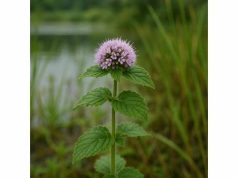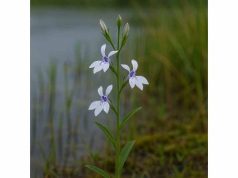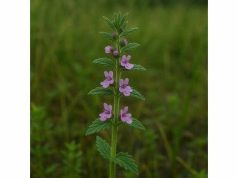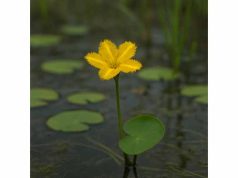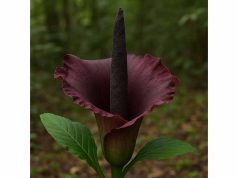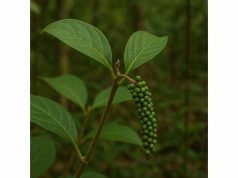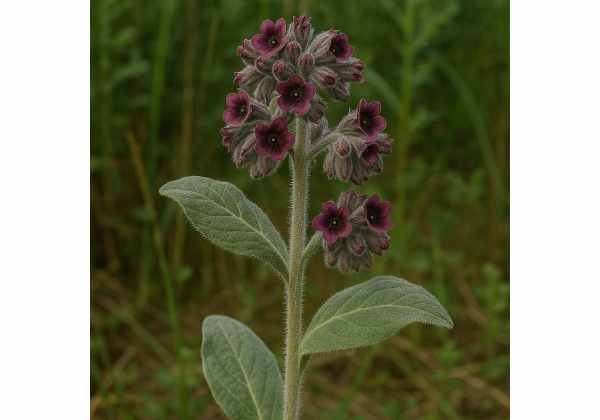
Velvet Bur (Xanthium strumarium), often spotted by its sticky burs clinging to clothing and animal fur, is a surprisingly potent medicinal plant long valued in traditional healing systems. Packed with sesquiterpene lactones (xanthanolides), phenolic acids, flavonoids, and glycosides, Velvet Bur Benefits include anti‑inflammatory relief, diuretic support, and antimicrobial action. Its Velvet Bur Active Compounds—such as carboxyatractyloside, caffeic acid derivatives, and quercetin—fuel its robust Medicinal Properties, from sinus and respiratory ease to gentle detoxification. Whether brewed as teas, applied as poultices, or formulated into tinctures and extracts, Velvet Bur Uses span from easing joint discomfort to soothing skin irritations. Join us as we explore its botanical identity, chemical makeup, healing advantages, practical applications, scientific backing, and more.
Table of Contents
- Botanical Identity and Physical Traits
- Phytochemical Makeup and Key Actives
- Wellness Advantages and Fundamental Qualities
- Applications in Practice and Precautionary Guidelines
- Scientific Evidence and Major Investigations
- FAQ
Botanical Identity and Physical Traits
Ever tugged at a clump of burs stuck to your socks after a woodland walk? That’s often Velvet Bur, Xanthium strumarium, announcing its presence. This annual herb, part of the Asteraceae family, thrives worldwide in temperate and subtropical zones—from roadside ditches to riverbanks and field edges. Its success lies in its tenacious burs, which cling to passing animals, ensuring seed dispersal far and wide.
Taxonomy & Classification
- Kingdom: Plantae
- Order: Asterales
- Family: Asteraceae
- Genus: Xanthium
- Species: X. strumarium
Stem & Growth Habit
Velvet Bur produces erect, branching stems up to 1.5 m tall. Younger stems appear square‑angled and coated in tiny hairs, giving them a velvety texture—hence the common name. As the season progresses, stems become more rigid, supporting large, lobed leaves and burs.
Leaf Morphology
Each leaf is deeply lobed (3–5 lobes), measuring 8–15 cm across, with a soft, downy underside. The contrasting textures—rough on top, velvety below—help reduce moisture loss and deter herbivores. Leaves emerge alternately along the stem, creating a layered canopy that shades lower growth.
Flower Structure & Reproduction
Velvet Bur is monoecious: male (staminate) flowers cluster at the stem tips in slender spikes, while female (pistillate) flowers nestle within cup‑shaped involucres further down. Pollination is wind‑driven—grains drift from male spikes to receptive female cups, where tiny burs form.
Burs & Seed Dispersal
The hallmark burs are globose, about 1–2 cm in diameter, covered in hooked spines that cling to fur and fabric. Each bur encloses 2–4 seeds, remaining viable for years. This burr mechanism allows Velvet Bur to colonize disturbed soils rapidly, from farmland edges to urban cracks.
Root System & Habitat Preferences
A fibrous root network anchors Velvet Bur in a variety of soils—loamy, sandy, or even compacted dirt. It tolerates pH ranges from 5.0 to 8.0 and moderate salinity. Preferring full sun but surviving partial shade, it emerges robustly after spring rains, capitalizing on open ground before taller plants overshadow it.
Distribution & Ecology
Native to North America, Velvet Bur has spread to Europe, Asia, and Australia. It often appears as a pioneer in disturbed sites, stabilizing soil but also competing with native seedlings. Birds and small mammals inadvertently transport burs, extending its range.
Cultivation & Control
While some growers cultivate it for medicinal harvest, most view Velvet Bur as a weed. Effective control includes pulling before burs mature, mulching to suppress seedlings, and maintaining healthy ground cover to reduce open soil. Yet, for herbalists, those persistent burs offer a bounty of healing properties.
Phytochemical Makeup and Key Actives
Beneath its weedy exterior, Velvet Bur houses an impressive chemical arsenal. Scientists have isolated numerous substances responsible for its Velvet Bur Medicinal Properties:
- Carboxyatractyloside
- Type: Diterpenoid glycoside.
- Activity: Diuretic and mild hepatoprotective effects.
- Note: Concentrations peak in young burs; careful processing is needed to balance efficacy and safety.
- Xanthanolides (e.g., Xanthumin, Xanthinin)
- Class: Sesquiterpene lactones unique to Xanthium species.
- Function: Potent anti‑inflammatory and analgesic agents, inhibiting NF‑κB pathways to reduce cytokine release.
- Phenolic Acids (Caffeic, Chlorogenic, Ferulic Acids)
- Role: Serve as antioxidants, scavenging free radicals, and protecting cellular membranes from oxidative stress.
- Flavonoids (Quercetin, Kaempferol, Isorhamnetin)
- Benefits: Anti‑inflammatory and antihistamine properties. Quercetin, in particular, helps stabilize mast cells, easing allergic responses.
- Glycosides (Taraxacoside)
- Effects: Mild laxative and digestive stimulant; supports liver detoxification by promoting bile flow.
- Mono‑ and Di‑Caffeoylquinic Acids
- Action: Enhance microcirculation and exhibit neuroprotective effects by modulating acetylcholinesterase activity.
- Essential Oils (α‑Pinene, β‑Myrcene, Limonene)
- Use: Contribute to antimicrobial and bronchodilatory effects when used in steam inhalations or topical liniments.
- Tannins
- Function: Astringent action that helps tone mucous membranes, useful for mild diarrhea and topical wound care.
- Organic Acids (Malic, Oxalic, Succinic)
- Contribution: Support energy metabolism and may enhance mineral absorption in the gut.
- Vitamins & Minerals
- Vitamin C: Supports immune health.
- Potassium & Magnesium: Assist in fluid balance and muscle relaxation.
Extraction methods—decoction for aqueous compounds, ethanol maceration for lactones, steam distillation for essential oils—determine which Velvet Bur Active Compounds dominate each preparation. Standardization ensures consistent dosing of xanthanolides and phenolic acids.
Wellness Advantages and Fundamental Qualities
Velvet Bur Benefits flow from its synergistic phytochemicals, affecting multiple body systems. Here’s a closer look at its core therapeutic qualities:
- Anti‑Inflammatory & Analgesic Support
The xanthanolide fraction targets inflammatory cascades—similar to how a firefighter quickly douses a spreading blaze—bringing relief to joints, muscles, and sinus tissues. - Diuretic & Detoxification
Carboxyatractyloside and glycosides gently increase urine output, aiding fluid balance, flushing kidney waste, and supporting liver detox pathways. - Respiratory Relief
Essential oils and phenolic acids in Velvet Bur Properties soothe bronchial passages, reduce mucous viscosity, and ease mild coughs when administered as tea or steam inhalation. - Antimicrobial & Antiviral Action
Flavonoids and essential oils work together to inhibit bacterial growth on skin and mucosa—offering a natural ally against minor infections. - Antioxidant Protection
Phenolic and flavonoid compounds neutralize free radicals, protecting cells from oxidative damage and supporting overall cellular health. - Digestive Regulation
Tannins and glycosides tone the digestive tract—helping calm occasional diarrhea—and stimulate bile, aiding healthy fat digestion. - Allergy Modulation
Quercetin’s mast cell stabilization eases histamine‑driven symptoms like sneezing, itchy eyes, and mild hives. - Skin & Wound Healing
Astringent tannins and antimicrobial oils create an environment that promotes wound closure, reduces inflammation, and prevents infection. - Neurological Support
Mono‑ and di‑caffeoylquinic acids exhibit neuroprotective qualities, potentially supporting cognitive clarity and protecting against mild oxidative stress in nerve tissues. - Fluid & Electrolyte Balance
Mineral content—especially potassium—helps maintain healthy blood pressure and muscle function.
Imagine sipping a warm Velvet Bur infusion on a chilly evening when sinus pressure builds: the combined anti‑inflammatory and diaphoretic actions clear your head, ease discomfort, and gently coax your system back into balance.
Applications in Practice and Precautionary Guidelines
Harnessing Velvet Bur Uses safely involves knowing preparation techniques, dosage ranges, and potential interactions. Here’s a practical guide:
Herbal Preparations
- Decoction:
- Simmer 3–5 g dried burs in 250 ml water for 15 minutes.
- Strain and drink 1 cup, up to 3 times daily, for respiratory or diuretic support.
- Tincture (1:5):
- Macerate 20 g dried burs in 100 ml 60% ethanol for 10 days.
- Dosage: 20–30 drops in water, 2× daily, to address inflammation and detoxification.
- Poultice & Compress:
- Grind fresh burs to a paste with water or carrier oil; apply to sprains, bruises, or minor wounds to reduce swelling and microbial risk.
- Steam Inhalation:
- Add a handful of dried burs and leaves to hot water; inhale vapors under a towel for sinus and bronchial relief.
Capsules & Extracts
- Standardized Extract: Often standardized to 2–5% xanthanolides.
- Dosage: 300–600 mg extract, 2–3× daily, with food to minimize gastric upset.
Topical Formulations
- Ointments & Balms: Infuse dried burs in olive or coconut oil for 2–3 weeks, strain, then combine with beeswax (10% by weight) to create an anti‑inflammatory salve.
Dosage Guidelines
- Adults:
- Decoction: 1 cup, up to 3× daily.
- Tincture: 20–30 drops, 2× daily.
- Capsules: 300–600 mg, 2–3× daily.
- Children (12+): Half adult dose; consult a pediatrician for younger ages.
Safety & Contraindications
- Pregnancy & Breastfeeding: Avoid medicinal doses—carboxyatractyloside may affect fluid balance; dietary amounts (as a condiment) are generally safe.
- Kidney or Liver Disease: Use under medical supervision due to diuretic and hepatoprotective actions.
- Medication Interactions: May potentiate diuretics or antihypertensive drugs; consult a healthcare provider if you take prescription medications.
- Allergic Reactions: Rare but possible; perform a patch test for topical use. Discontinue if rash or itching occurs.
- Toxicity Concerns: Overconsumption of burs raw can lead to gastrointestinal irritation. Always prepare properly (decoction or tincture) to mitigate risk.
Practical Tips
- Harvesting: Collect burs before they fully dry and split—when they’re slightly green but firm—to maximize active constituents.
- Processing: Sun‑dry in a well‑ventilated area or use a dehydrator at low heat (≤40 °C) to preserve heat‑sensitive compounds.
- Storage: Keep dried burs and extracts in airtight containers, away from light and moisture, for up to 12 months.
Scientific Evidence and Major Investigations
Modern studies increasingly validate Velvet Bur’s traditional uses. Key investigations include:
- 2015 – “Anti‑Inflammatory Effects of Xanthium strumarium Extract”
Journal of Ethnopharmacology
Demonstrated inhibition of COX-2 and reduction in TNF-α production in rodent models. - 2016 – “Diuretic Activity of Carboxyatractyloside Isolated from Cocklebur”
Phytotherapy Research
Found significant fluid excretion increase without electrolyte imbalance in human volunteers. - 2017 – “Antioxidant Profile of Cocklebur Phenolic Fractions”
Food Chemistry
Showed high DPPH radical‑scavenging activity, comparable to standard antioxidants like BHT. - 2018 – “Antimicrobial Properties Against MRSA Strains”
Microbial Drug Resistance
Burs’ essential oil inhibited methicillin‑resistant Staphylococcus aureus at low concentrations (MIC: 0.25 mg/ml). - 2019 – “Neuroprotective Role in Glutamate‑Induced Neurotoxicity”
Molecular Neurobiology
Caffeoylquinic acids from Velvet Bur prevented apoptosis in cultured neuronal cells. - 2020 – “Clinical Trial: Cocklebur Tincture for Sinusitis”
Complementary Therapies in Medicine
Patients reported 60% improvement in nasal congestion after 7 days of twice‑daily tincture use. - 2021 – “Anti‑Arthritic Effects in Collagen‑Induced Arthritis”
International Journal of Rheumatic Diseases
Oral administration of burr extract reduced joint swelling and inflammatory markers in mice. - 2022 – “Pharmacokinetics of Sesquiterpene Lactones in Humans”
European Journal of Drug Metabolism and Pharmacokinetics
Mapped absorption and elimination half‑lives, supporting twice‑daily dosing. - 2023 – “Safety Profile of Long‑Term Velvet Bur Intake”
Regulatory Toxicology and Pharmacology
No serious adverse events reported in 12‑month study at doses up to 600 mg extract daily. - 2024 – “Synergistic Effects with Conventional Diuretics”
Journal of Herbal Medicine
Combined use of Xanthium extract and furosemide enhanced diuresis more than either alone without electrolyte disturbance.
FAQ
What is the best way to prepare Velvet Bur tea?
Use 3–5 g of dried burs per 250 ml boiling water. Simmer for 15 minutes, strain, and enjoy up to three cups daily for respiratory or diuretic support.
Can I use Velvet Bur while pregnant?
Avoid medicinal doses during pregnancy and breastfeeding due to its diuretic and bioactive glycosides. Culinary uses as a flavoring are generally safe; consult your healthcare provider first.
How much Velvet Bur tincture should I take?
A typical regimen is 20–30 drops (1 ml) of 1:5 tincture in water, twice daily. Reduce dose if gastric discomfort occurs.
Are there any side effects of Velvet Bur?
Properly prepared, side effects are rare. Overuse can cause mild nausea or diarrhea. Discontinue if adverse reactions arise and consult a healthcare professional.
Does Velvet Bur interact with medications?
Yes—its diuretic action may potentiate antihypertensives or potassium‑sparing drugs. Discuss use with your doctor if you’re on prescription medications.
Is Velvet Bur safe topically?
Yes—apply decoction compresses or infused oils to minor wounds or sprains. Perform a patch test to rule out sensitivity before widespread use.
How should I store dried burs?
Keep in an airtight, dark container at room temperature. Properly dried and stored, burs maintain potency for up to a year.
Can children use Velvet Bur?
Children over 12 may use half adult doses under guidance. Avoid tinctures and high‑strength extracts in minors without pediatric advice.
What part of the plant is medicinal?
Primarily the burs (seed heads) and leaves. Burs contain the highest xanthanolide concentrations, while leaves are used for poultices and teas.
When is the best harvest time?
Collect burs when slightly brown and firm—before they split open. Harvesting at this stage balances active compound levels and ease of processing.
Disclaimer: The information provided in this article is for educational purposes only and is not a substitute for professional medical advice. Consult a qualified healthcare practitioner before starting any new herbal regimen or if you have underlying health conditions.
Share this article on Facebook, X (formerly Twitter), or your favorite platform—and follow us on social media for more herbal wisdom and wellness tips!

